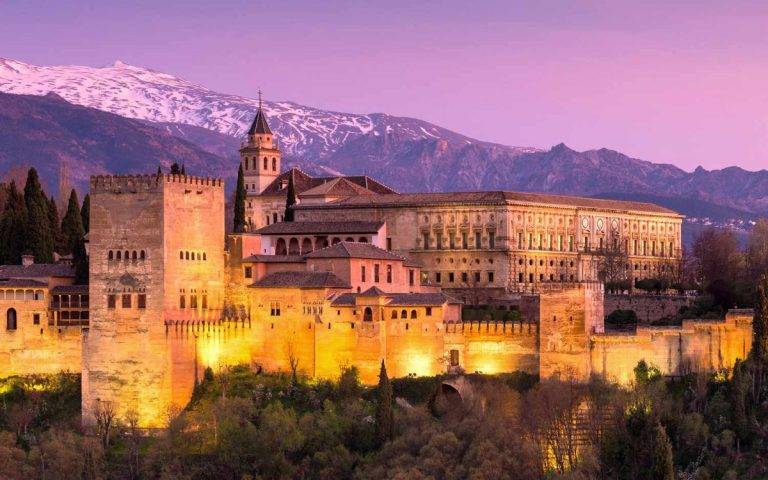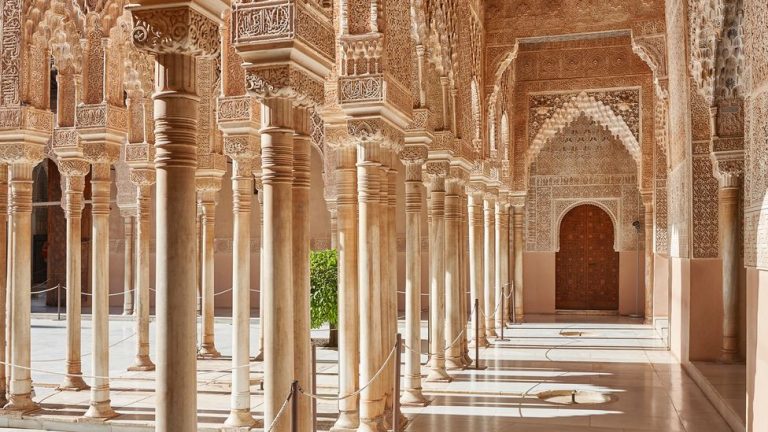Discover the Alhambra Palace of Granada: A Timeless Jewel of Moorish Spain
Tucked into the hills of southern Spain. Overlooking the charming city of Granada, the Alhambra Palace stands as a captivating blend of history, architecture, and cultural legacy. This iconic UNESCO World Heritage Site is not just one of Spain’s most visited landmarks—it’s also one of the most enchanting palaces in the world. Whether you’re a history buff, an architecture enthusiast, or simply a curious traveler in search of breathtaking beauty, the Alhambra Palace is a must-visit destination that deserves a place on your travel bucket list.
What is the Alhambra Palace?
The Alhambra is a sprawling fortress-palace complex that dates back to the mid-13th century. Originally constructed by the Nasrid Dynasty—the last Muslim dynasty to rule in Spain—the Alhambra served as a royal residence, court, and fortress. Its name, derived from the Arabic “Al-Qal’a al-Hamra,” means “The Red Castle,” a nod to the reddish hue of its ancient walls.
Set against the dramatic backdrop of the Sierra Nevada Mountains, the Alhambra is a stunning example of Islamic architecture and design. Its intricate calligraphy, geometrically precise tile work, tranquil courtyards, and flowing fountains create an atmosphere of serenity and splendor unlike any other historical site in Europe.
Why Visit the Alhambra?
1. Step Into a World of Moorish Splendor
Walking through the Alhambra is like stepping back in time to medieval Andalusia. The palace complex is made up of multiple buildings, gardens, towers, and courtyards—each with its own story and significance. The level of detail in the carved ceilings, arabesque walls, and reflecting pools showcases the craftsmanship and artistic vision of the Nasrid architects.
2. A Photographer’s Paradise
From sunrise to sunset, the Alhambra offers a picture-perfect setting for travelers who love photography. The play of light and shadow on the palace’s ornate walls, the sweeping views of Granada below, and the lush gardens of Generalife make for an unforgettable photo journey.
3. UNESCO World Heritage Status
The Alhambra, along with the Generalife and the Albayzín district of Granada, was declared a UNESCO World Heritage Site in 1984. This recognition ensures the site’s preservation and highlights its global cultural importance.
Must-See Highlights of the Alhambra Palace
1. The Nasrid Palaces (Palacios Nazaríes)
This is the crown jewel of the Alhambra. A visit to the Nasrid Palaces reveals an intricate maze of rooms and halls adorned with stucco carvings, mosaic tiles, and wooden ceilings. Don’t miss the Hall of the Ambassadors, where diplomatic meetings once took place, and the Courtyard of the Lions—famous for its central fountain supported by twelve marble lion statues.
2. The Alcazaba
The oldest part of the complex, the Alcazaba is a military fortress that offers panoramic views of Granada. Climb to the top of the watchtower (Torre de la Vela) and soak in the incredible vistas of the city and surrounding mountains.
3. Generalife Gardens
Adjacent to the palace, the Generalife was the summer retreat of the Nasrid rulers. Its name means “Garden of the Architect,” and it lives up to the title with beautifully landscaped terraces, tranquil water features, and blooming flowers. The gardens are especially vibrant in spring and summer.
4. Palace of Charles V
After the Christian reconquest of Granada, Emperor Charles V added a Renaissance-style palace within the Alhambra complex. Its circular courtyard and contrasting architecture provide a unique juxtaposition to the Islamic designs of the rest of the complex.
Best Time to Visit
The Alhambra is a popular tourist destination year-round, but the best time to visit is during the spring (April to June) and fall (September to November). These seasons offer mild temperatures, blooming gardens, and fewer crowds compared to the busy summer months.
To make the most of your visit, it’s recommended to book tickets well in advance, especially for the Nasrid Palaces, which have limited entry per hour.
How to Get to the Alhambra
The Alhambra is located on Sabika Hill in the city of Granada, Andalusia. Travelers can reach Granada by train, bus, or car from major cities like Seville, Madrid, and Malaga. Once in the city, the Alhambra is accessible via local buses, taxis, or even a scenic uphill walk from the city center.
Ticket Information and Guided Tours
There are several types of tickets available for the Alhambra:
General Admission – Includes access to the Nasrid Palaces, Generalife Gardens, and Alcazaba.
Night Visit Tickets – Offers a magical view of the palaces under ambient lighting.
Guided Tours – Ideal for those who want to delve deeper into the history and symbolism of the complex.
Prices vary depending on the season and type of ticket. It’s advisable to buy tickets from the official Alhambra website or trusted vendors to avoid scams or markups.
Travel Tips for Visiting the Alhambra
Wear comfortable shoes: The site is large and involves a lot of walking.
Arrive early: Morning visits allow you to enjoy the site with fewer crowds and softer light.
Bring water and snacks: While there are cafes nearby, the complex itself has limited refreshment options.
Don’t rush: Give yourself at least 3–4 hours to fully explore the Alhambra and appreciate its beauty.
Where to Stay Near
Granada offers a range of accommodation options, from luxurious hotels to cozy guesthouses. For an unforgettable experience, consider staying in the Albayzín district—a historic area with whitewashed houses, narrow streets, and unbeatable views of the Alhambra, especially at sunset.
Some travelers also choose to stay in boutique hotels or converted Andalusian homes (cármenes), which offer a blend of local charm and modern comfort.
Nearby Attractions
While the Alhambra is the main attraction, don’t miss these nearby gems:
Albayzín: The old Muslim quarter with winding alleys and scenic viewpoints like Mirador de San Nicolás.
Sacromonte: Known for its cave houses and flamenco shows.
Granada Cathedral: A majestic Renaissance cathedral built after the Reconquista.
Tapas Culture: Granada is famous for its free tapas. When you order a drink, a delicious tapa comes with it—perfect after a long day of exploring!
Final Thoughts: Why the Alhambra Palace Should Be on Your Travel List
If you’re planning your next tour and searching for places that blend history, culture, beauty, and unforgettable experiences, the Alhambra Palace of Granada should be at the top of your list. It’s more than a monument—it’s a living narrative of Spain’s complex past and a shining example of architectural genius.
Whether you’re traveling solo, with family, or with friends, exploring the Alhambra offers a perfect mix of inspiration and relaxation. From the whispering fountains to the poetic inscriptions on palace walls, every moment spent here is a step deeper into a story that has endured for centuries.
Start planning your visit to the Alhambra today—and let Granada’s crown jewel leave a mark on your heart.
The fall of Granada in 1492 marked the end of Muslim rule in Spain and the Alhambra was subsequently used by the Catholic Monarchs, Ferdinand and Isabella. Over time, it served various purposes, including as a military barracks and a place of residence for Charles V, who constructed a Renaissance-style palace within the Alhambra grounds. Despite changes and periods of neglect, the Alhambra has been preserved as a symbol of Spain’s diverse cultural heritage.
A Symbol of Culture
It is an immense cultural and historical importance in Spain, representing a harmonious blend of Islamic and Christian influences. It stands as a testament to the country’s complex history and the coexistence of different cultures. The intricate architecture and artistic achievements of the Alhambra continue to inspire artists and architects worldwide.
For More Info: Alhambra
Similar Places: Sipi Falls
Pinos Puente
Andalusia
18240
Spain
Sorry, no records were found. Please adjust your search criteria and try again.
Sorry, unable to load the Maps API.


